| About a virus |
| There are countless viruses in the earth. A virus which infects a human being and other animals, a virus which infects animals other than a human being, and so on. |
| Four viruses which do mischief to man are shown below. There are many viruses which annoy to man other than these |
| |
|
|
|
poliovirus
A cause of disease virus of polio (acute polio meningitis) |
norovirus
A virus which causes bacterial acute gastroenteritis |
influenza virus |
rotavirus
A cause of infant diarrhea , vomiting diarrhea |
|
| �i�P�jAbout a virus and organ damage |
Each virus varies in the organ which is easy to be adhered to each.
That is, a rotavirus and a norovirus is easy to settle down in intestines.
An influenza virus is easy to adhere to a mucous membrane of bronchi and a throat, and the heart.
It is hard to adhere to the organs such as a liver and the kidney.
It seems that new type influenza virus does mischief also in a lung unlike the conventional seasonal form influenza virus.
HB (B type) virus and HC virus (C type) mainly worsens a liver, but does not affect other organs.RS virus, which is found with cold condition at the age of 1-2, affects respiratory organs, but not for other organs. |
| �i�Q�jLet’s look at the size of a virus |
|
This virus is a norovirus. It is the larger one. |
We changed the picture in the section of “Let’s learn about a virus” on HP of Hiroshima city Institution of Public health.
http://www.city.hiroshima.jp/shakai/eiken/kan_center/k_topics/v_syiro/v_syiro-01/v_syiro-01.htm
|
A virus is very small, and can be seen only with an electron microscope.
Although bacteria are visible by 1000 times of an ordinary microscope, a virus is visible at last by 10,000 times. |
| When a norovirus is enlarged to 50 million times, it becomes just the size of a human being of the height of 1.8 m. |
|
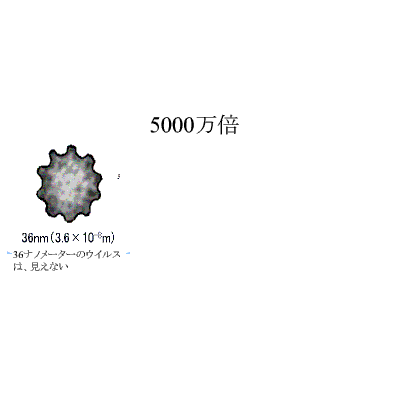 |
|
 |
|
When a human being of 1.8 m tall is enlarged to 50 million times, it will become a huge human being. It is a human being of the height that the earth forms a line for seven. |
| In other words, a virus is a one - 50 millionth size for a human being of 1.8 m tall. |
| If we think that a virus is a 1.8 m tall size, a human being becomes the height of one-quarter of the distance to reach the moon. You will see how small a virus is, won’t you? |
|
|
|
Then, how does out cell invaded by a virus fight with the virus?
A macrophage and a white blood cell eat a virus outside the cell.
Medicine does not work.
Why do you think it is?
A virus gains entrance into our living cell and increases.
The medicine which kills a virus will kill our body as well.
It is because that killing a virus means it also damages our cell.
It is troublesome. |
|
�i�R�jWell, how does a virus get into our cell?
Let’s see an influenza virus as an example.
|
Many influenza viruses are in the phlegm of those who have been infected.
A virus flies to the surroundings by a sneeze and a cough..
When we inhale it, we easily get infected.
In addition, we also get infected easily when we touch the thing which the person having the flu touched and bring the dirty hand to our mouth.
|
|
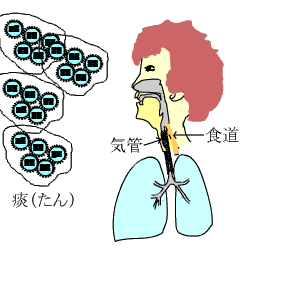 |
|
|
|
An influenza virus contacts with a tracheal epithelial cell.
Since a tracheal epithelial cell has the cell membrane which is easy to combine with a virus, a virus is taken in in a cell.
Other foreign substances as well as a virus may be taken in. |
A virus is shut in a cell by a small bag called endosome.
In many cases, the thing taken in here is broken down, but the virus leaves in a cell without being broken down. |
The gene which forms a virus moves to a nucleus and many genes of the virus itself are made there, and mRNA which makes the protein of a virus is also made.
A lot of proteins of the virus are made with the work of mRNA. |
Viral genes and proteins made a lot move to the cell membrane.
The protein of a virus adheres to a cell membrane, encloses a gene, and comes out of a cell. |
|
|
|
|
|
It is called budding.
This is how the influenza virus comes out of the somatic cell.
|
The source: Tokyo University’s institute for medical science infection international research center, Dr. Takeshi Noda, Dr. Yoshihiro Kawaoka
winter vol.36.-4. p 40
Infection. Inflammation, immunity Iyaku No Mon winter vol.36-4 p..40 |
|
|
 :Tamiflu :Tamiflu
It is the medicine which hinders a lot of viruses exiting the cells. |
| �i�S�jNext, let’s simply watch the mechanism which a dendritic cell takes a virus in by an animation. |
let’s remember�@  :dendritic cell :dendritic cell
When a virus which is a foreign substance for a human being, |
bacteria and mold enter the body, the cell lets it know the immune cell. |
| �@Reaction of MHC class 2 molecule |
The animation below shows a dendritic cell. The green round one is the cell which infected a virus and died.
Naturally the viruses do not increase because a cell is dead. The residue is shown in brown. Please watch the change of a virus taken in. |
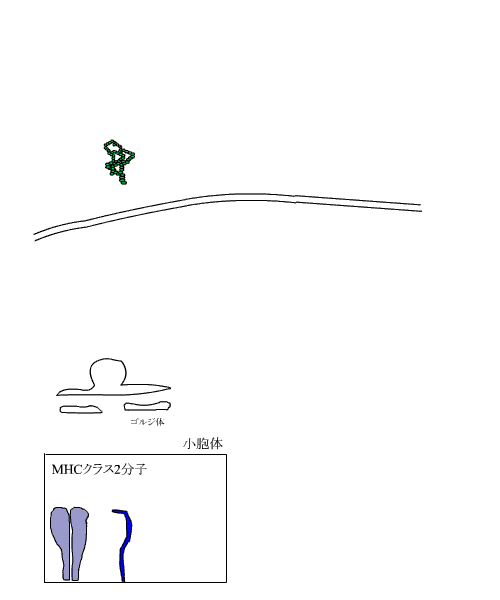 |
A virus cannot multiply in the dendritic cell. There is the structure which it cannot multiply.
A virus becomes fine, and a part of it adheres to MHC class 2 molecule, and shows up out of a cell membrane. |
| It means that this dendritic cell presented the virus (antigen). |
| A helper T cell becomes easy to adhere to a transformed MHC class 2 molecule. |
|
|
A substance called cytokine goes out of a helper T cell.
Please see the “acquired immunity” |
|
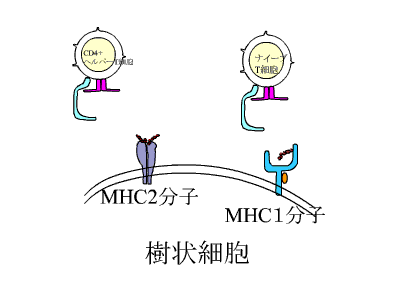 |
|
| �AThe reaction of MHC class 1 molecule |
| The cell called a naive killer T cell responds to the cytokine which come out from a helper T cell, and reacts to the cytokine which come out from a dendritic cell. |
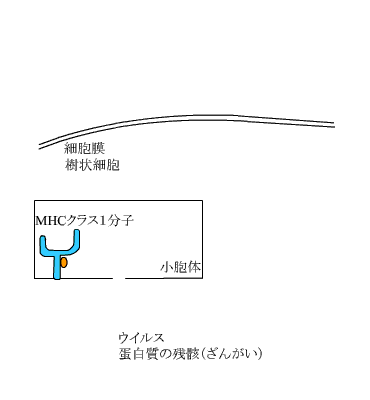 |
The cell called a naive killer T cell appears.
This cell reacts to the state where MHC 1, which exists in a dendritic cell as well, caught the residue of a viruses. |
Thus, both MHC 1 and MHC 2 react to the residue of a virus in a dendritic cell.
 |
|
|
The naive killer T cell which responded a MHC 1 molecule gets active. |
| �BThe reaction to a killer T cell of a naive killer T cell |
| The naive killer T cell which become active makes a killer T cell active. |
| What will the killer T cell which recovered its strength do? |
A killer T cell is not usually working.
The cytokine which come out from a naive killer T cell makes a killer T cell active. |
|
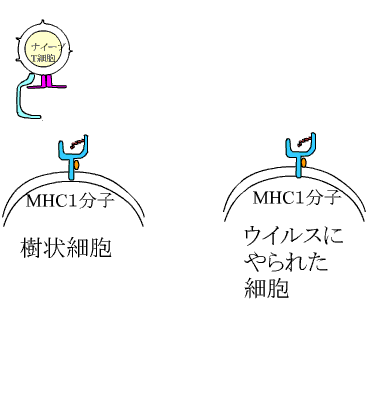 |
|
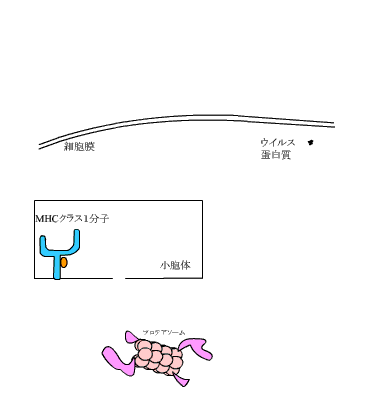 |
The active killer T cell processes a damaged cell.
In other words, it processes the cell which the virus multiplied in, the cell damaged by the bacterial toxin, and the cell invaded by cancer.
This prevents a virus and cancer from spreading. |
| A cytokine makes a killer T cell active in lymphatic tissue. |
A virus is cut into a certain size in a cell where a virus increased.
A fragment adheres to a MHC class 1 molecule. This shows up outside a cell. |
|
|
The killer T cell which became active by the cytokine which came out of the naive killer T cell adheres to this transformed MHC class1 molecule.
After this, a substance appears from a killer T cell and processes the damaged cell. |
|
the cell attached by a virus |
When a killer T cell adhered to the cell attached by a virus, a substance called perforin appears.
Perforin makes a hole in a cell membrane.
A substance called granzyme goes into a damaged cell from a killer T cell through the hole.
Granzyme damages further our damaged cell and tidies it up.
|
|
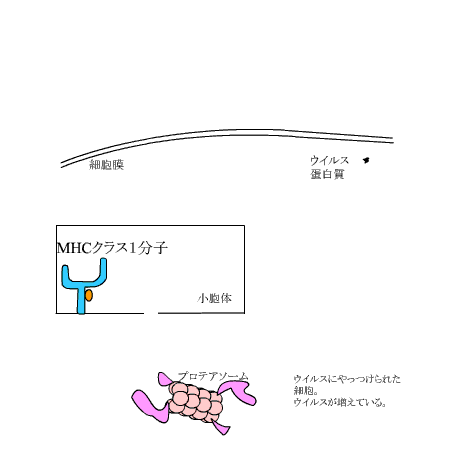 |
|
| |
A structure which a virus is defeated.
|
A virus goes inside the body.
 |

A cell is damaged by a virus.
|
A fragment of a virus appears from a cell.

|

A dendritic cell finds a virus.
|
A helper T cell reacts to a dendritic cell which took in a fragment of a virus.

|
|
A naive killer T cell which became active makes a killer T cell active.

|
A naive killer T cell reacts in the same dendritic cell.

|
A killer T cell which became active defeats the cell damaged by a virus. A virus cannot multiply either. |
|
|
|
| (5) What’s the difference between MHC class 1 molecule and MHC class 2 molecule? |
It is a difficult matter.
Almost all cells of the body have the mark called MHC class 1 molecule peculiar to the person.
This is like the fingerprint distinguished from others' cell.
The cell where the virus multiplied is processed since it is useless. At that time, a killer T cell makes a MHC class1 molecule the mark and processes.
On the other hand, a cell which catches a foreign substance such as a virus, that is an antigen, like a dendritic cell, has inside the cell the system where a virus cannot multiply.
Moreover, a dendritic cell can react to a helper T cell not a killer T cell by having a mark called MHC class 2 molecule.
A helper T cell which adhered to a dendritic cell and became active makes a killer T cell active.
Thus, the difference between MHC class 1 molecule and MHC class 2 molecule shows the role of the cell.
When the reaction of an antigen and an antibody continues, and the body regains energy, a killer T cell also adheres to a MHC class 1 molecule of a dendritic cell.
A dendritic cell dies. The reaction of immunity finishes.
It is said that the cells related to immunity are 10 trillion cells of all 60 trillion cells. |
 |
|
|
 |